Electricity is one of my favorite topics, there’s so much that goes into it that it’s like a giant puzzle waiting to be pieced together. (can you tell I’m a nerd?)
My electrical background comes from my real job, I’m the owner of Walnut Wood Works, and as owner that means that I’m also the maintenance man, the machinery repair man and electrician!
We deal with a lot of heavy machinery pulling a lot of electricity on a daily basis so the RV wiring is a walk in the park by comparison. Almost.
The beauty/horrifying reality of an RV is that there are not 1 but 2 distinct electrical systems. There’s the DC system that runs all your lighting and DC appliances (all the 12V stuff) and then there’s the AC side that runs your air conditioners, fridge etc. This wouldn’t be a real challenge if they didn’t connect together in several places now would it? Add all that together and you get a pretty solid cluster-**** of wiring.
As with everything else with this project, we weren’t happy about how it was done in the 70’s. The technology just wasn’t there yet. So we started from scratch! (of course)
We will start with a basic background on how the RV electrical system works, if you already know this great, skip on ahead, if not read on and maybe you’ll learn a little something that can save you a repair bill down the line.
A stock GMC (or most any RV) has 2 120V AC power sources, those are the generator and the shore power connection. These supply standard household 120V power to power your AC’s, water heater, Fridge, outlets, and your converter. These are interchangeable. While boondocking you run the generator, in a park you connect to shore power.
Similarly there are 2 sources of 12V DC power as well. Your house batteries power everything in the “house” and your engine battery that powers everything in the dash and engine compartment. (this also powers your stock compressor for electrolevel).
The AC side is pretty familiar to most, it’s the same as whats in your house. Hot neutral and ground etc. I’m not going to go into that because you either know how to do it, or you should leave it to a professional so you don’t burn down your coach!
The DC side is pretty simple. You’ve got your battery(s), your distribution center, the wiring, and your loads.
We’ll start with batteries:
Most (me included) recommend using 2 6V deep cycle batteries in series to get 12V. There’s a few reasons for this but basically you get more bang for your buck and more power from your batteries. 6V Golf cart batteries like the Trojan T105 are preferred. They put out somewhere around 200-250 AH depending on the brand and model. But what the hell is an AH? It’s a measure of how much power your battery can store. The higher the number the more juice you’ll have on reserve, (complicated subject, but that’s the gist)
Distribution:
The distribution center in the GMC’s is also outdated with glass fuses. We recommend replacing this with a nice new 12V Fuse box with blade fuses that are a lot easier to see when blown, and in this day and age a lot easier to find replacements for if you’re in the middle of nowhere. Most every gas station carries blade fuses, I’m noticing fewer and fewer with glass fuses.
I prefer marine parts to RV parts. In my experience things built for marine use are better quality than those for RV use. To me RV Parts=Cheap. We don’t stock any at the moment, but we like the Blue Sea products (marine).
From here your wiring is likely fine if it works, don’t fix it.
Lighting:
The lighting stock in a GMC is standard 12v halogen. There’s nothing wrong with this and if it works for you keep on keeping on. However, newer better tech is available. LED lighting draws 1/10 the power for the same light as an incandescent. Read the lighting post HERE for specifics. Less power draw= more time on your batteries and less time on the juice! Basically if you run nothing but lights, you can stay out 10X longer with the LED’s than you could with the standard 12v halogens. That’s a big ass difference!
Converter:
Your Converter is the interface between the 12v DC and 120v AC systems. In it’s simplest form the converter is a battery charger. When you connect to power (be it shore or generator) your converter does the job of charging your batteries on the DC side. One of the best and easiest upgrades you can make for your GMC is to replace the stock converter with a new unit. The stock converter is so far behind today’s battery and charger technology that it’s not even funny. A new converter from Progressive Dynamics or whoever you choose will provide faster charges, fuller charges, and most importantly it has a little tiny guy inside that tells the converter “hey dipshit the battery is full! Stop charging it” that the stock converter doesn’t have. Seriously, upgrade the converter if you care for your batteries.
Today’s converters use complex charge algorithms, but in essence what they do is 3 stages.
- Bulk charging is first, that’s at 14.2ish volts and this is what really pumps the juice into your batteries. This goes from 0% charge to roughly 90% charge. This will vary in power based on your converter but will start near the maximum amp rating (60,55,45 amps etc) and taper down from there as the battery fills. Think of amps as how much water is coming out of the hose, a large hose with a lot of water fills a bucket to 90% faster than a small hose with less flow. The same applies to a converter, a 60 amp converter will fill your battery faster than a 45 amp converter. (at least to the 90% mark and limited by what your batteries can take).
- Absorption charging is next. It bumps the voltage down to 13.6 or so and holds it there. The current is then limited (amps in) to keep your battery from overheating and boiling off the water while it fills to 98% or so.
- Float Charge is the last stage. It bumps the voltage down even further to 13.2 ish volts and holds it there with very little current flowing. This tops off the battery and then keeps it at 100% without doing any damage. to your batteries.
In contrast, the stock 70’s charger charges at one voltage and let’s the battery handle the excess charge, this ends up boiling the battery and ruining it in the long run.
Inverter:
The GMC didn’t come with an inverter stock. An inverter is the opposite of a converter. It turns your 12V DC battery power into 120V AC power for use with televisions, outlets etc. Most people have used or are using an inverter in their RV. A few notes on inverters:
You HAVE to run big wire to an inverter. These things pull a LOT of current from the batteries and must be treated with respect. You cannot use a 10 gauge wire to connect an inverter. Many people make the mistake of undersizing these wires. This causes severe voltage drop and major bottlenecking, more importantly it can burn your RV to the ground if you’re pulling too much power through too little wire. I’m a big proponent of overkill. If you’re going to use an inverter read the specs and go at least one wire size bigger than the manufacturer recommends. Another common mistake is distance. Again you’re pulling a lot of current here, you want an inverter as close as possible to the battery. less than 4 feet of wire ideally. So don’t put your inverter up front and run tiny wires through the roof and over the floor and around the water tank and up through the walls and then back down to your battteries. Not only is it not safe, it’s also going to draw a whole lot more power to power your electronics than necessary, meaning once again less battery time.
Solar:
Solar is another add on that can help with your batter issues. A solar controller is really just another battery charger. You connect it to the solar panels and the batteries (again, big wires, short distances) and BAM free power any time you’re in the sun. There are a ton of options in the solar realm and I’ll probably do a whole post on that at some point. But for now, a couple hundred watts of solar will keep your batteries charged and your lights on longer. You’re not going to run your fridge, or your ac’s on solar, but you can extend your boondocking and overall battery life.
Battery Monitors:
If you haven’t caught on by now, this is all about the batteries! They need to be properly cared for, treated nicely, and used appropriately. To do this you need information. You need to know how much power you’re drawing, how much charging you’re getting, how much time you have left etc. This is where a battery monitor comes in. The monitor uses a shunt (which in essence measures current flow through it) to measure all the power into and out of the battery. It then does a lot of math and tells you all the things you need to know about your batteries ie: how charged are they? How much power are my lights pulling? what’s my voltage? is my converter working? Is my solar charger working? If I move over into more sun do I get more power? Do I need to start the genset and recharge? Etc etc. We use the Vicron BMV700 that’s available in the store because, well frankly I think it’s the best one out there for a reasonable price. It tells you all the things you need to know, and even cooler is you can bluetooth all that info to your phone so you can see it without having to scroll through the tiny screen on the monitor.
Transfer Switch:
A transfer switch simply automates the swap from shore power to generator power so you don’t have to unplug and replug the shore power cord. This is very convenient and we highly recommend it! We also are using a separate transfer switch to switch between inverter power and shore power for a select few appliances. More on that later when I do a post on our specific electrical system.
Alternator:
So far we have only discussed the house batteries. The alternator charges the engine battery when you’re driving. The GMC comes with an isolator so that it also charges the house batteries. The isolator once again is from the 70’s and there’s better options these days. The easiest thing to do it add a Battery Combiner which has another little microprocessor that tells it to connect or disconnect the house and engine batteries so you can charge both at the same time. (ie the alternator will charge the house batteries and the converter will charge the engine battery) This can be added to the existing isolator in about 10 minutes with no modifications.

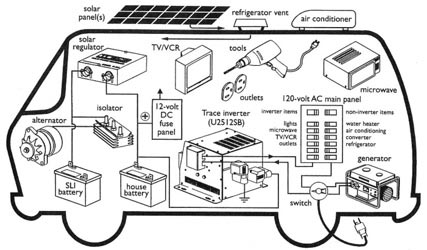
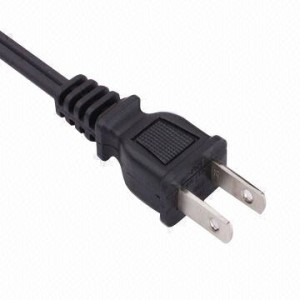
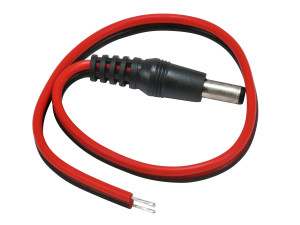
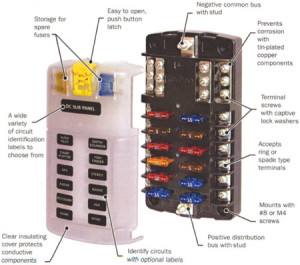
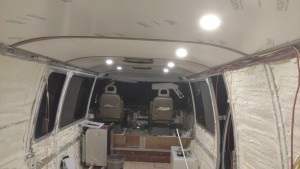
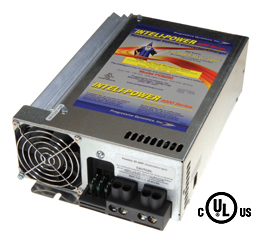
Very informative article. Since I am relativity new to this site, a little hesitant to post advice. As an electrician for over 40 years, one thing I have not seen posted is that people do not have an earth ground when running off the generator only, unless the coach is still plugged into shore power source. That is why all receptacles should be of the GFI type in the coach. I am sure folks would not be wanting to pound in two 8 foot ground rods 6 feet apart every time they ran their generator.
This is the only thing I’ve understood, by virtue of being a former boat Captain. We had the golf cart batteries in series, high output alternators. would you recommend the high output Marine alternator vs. the automotive one? Thanks, Gerald
Hey Gerald,
The only real difference in the Marine alternators and Automotive alternators is that the marine versions are ignition protected, so that they aren’t able to ignite fuel vapors in the hull and blow up boats! A high output automotive alternator will work fine in a motorhome. Many have upgraded to a 100+ amp alternator (stock is an 80 amp except for 1978 which had a 145 amp!) You can go even bigger if you want, depending on how many batteries you have to charge and how much you drain them.
Thanks Justin, I was loading a trailer with junk to take to the dump when I ran across a former number one alternator that would need rebuilding, and thought that would make a good back up. My mechanic who just replaced my rear brake system found that one of the two batteries located on the passenger side of the coach under the hood was missing a ground wire and the starter was fixing to be bad so he replaced that also. Going the have to sell my 34 Airstream so I can afford to get the ole “Rock Star” back on the road. Still don’t know anything about the refrigerator. Gerald
Thank you ever so for you forum post. Keep writing. Morphis
Thanks so much for writing this post. I have been studying it. I have general knowledge of home electrical and repair but the ideas of inverters and converters is all new and confusing. Breaking it down like you did has definitely given me a better idea of what needs to be done!
Just starting the Adventure, have 77 GMC RV. Lots of things to find out. All I can say is the engine runs so far.
Love the drawing and the breakdown of each area. I didn’t realize there was so much behind the walls of my rig. I’m so scared to mess with anything electrical or propane. This helps lessen the fear factor since I can see and understand the mechanics. I think I am becoming an electrician, auto mechanic, and so much more with each and every RV issue I encounter. Thanks for sharing the details so us newbies can understand this!
I am happy I ran across this post it answered many questions I needed answered